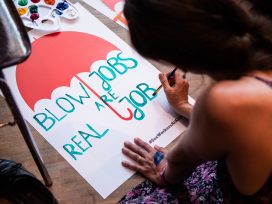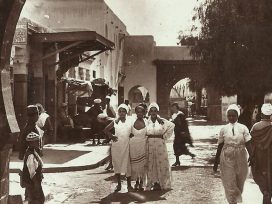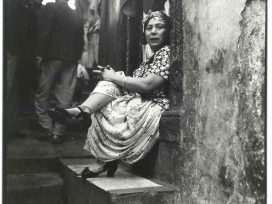Sex in colonial empires and its legacy in Europe today
An interview with Christelle Taraud
Feminist historian Christelle Taraud talks about the patriarchal system for regulating prostitution in France’s colonial empire, a system made by men for men to reserve indigenous women for their own use and control the ‘unruly’ sexuality of men from honour cultures. These issues are covered in ‘Sexe, race, et colonies’ (2018), co-edited by Taraud, which has proved controversial in France for its unsettling imagery.
The hefty four kilogram tome Sexe, race et colonies (2018) questions sex in the colonial era. The racialized construction of gender representations during this period has had considerable impact on European cultures, but the book sparked major controversy in France due, in part, to its images; it was accused of aestheticizing the indefensible, violating the rights of those depicted, voyeuristic sensationalism, and of being pornographic. Co-editor Christelle Taraud’s work is about the centrality of sex in colonial societies. There is, however, a clash between her thought and the ‘minority question’ in third-wave feminist movements in the #MeToo era.
Green European Journal: You have studied women in a colonial context, mainly in North Africa, for a long time, publishing several books on the subject. How did you start working on this?
Christelle Taraud: I wanted to work on North Africa and women for two reasons: a commitment to militant feminist and my family history. While looking for a way into this subject during my PhD research on the colonial system for regulating prostitution, I came across reports by doctors working in the interwar period. They seemed to indicate that it had been a massive institution in French-ruled north Africa. Then I realized that prostituted women were, for the most part, indigenous, and that something was playing out that went beyond the control and management of poor women’s sexuality. What they said about these women was, moreover, condescending, masculine, and white. This regulatory system had been put in place by men for men: it talked endlessly about women without women themselves ever being heard. That’s what Michelle Perrot says in Les femmes et les silences de l’Histoire (2012).These women were, as well as being prostitutes in a ‘whorephobic’ world, not just women, but poor, colonized subjects. The silence surrounding them is deafening. I then tried to do biographical work on the paths these women took, pursuing their unique, complex stories with as little prejudice as possible. In other words, I took the tiniest traces of their words seriously, starting from the principle that they weren’t complete victims unable to defend themselves. They were, in fact, capable of acts of ‘micro-resistance’. When repeated, these acts can undermine a system, bringing it down from within. That’s what these women did.
GEJ: Sexe, race et colonies contains a rich iconography with over 1,200 images selected from a corpus of 70,000 documents: private photos, postcards, advertisements, and so on. How do images play a major role in constructing representations of gender in the context of colonization?
CT: I studied the image, perception, social imaginary, and the private and public fantasies associated with these women. The pioneering work of Edward Saïd and Michel Foucault had blind spots: Foucault on colonialism and ‘race’, Saïd on feminism and women, as many feminist scholars have since demonstrated. I have been arguing for a feminist critique of Orientalism since the mid-1990s. I think I was one of the first female historians to say that orientalist paintings from the first half of the twentieth century weren’t really about the Orient. There’s a major misunderstanding: the women in them are presented as ‘orientals’ because it allows them to be undressed by giving them an exoticized femininity. They are, however, white Parisian models painted as Algerian women’, at least in the first phase of orientalist painting. Black women were systematically side-lined in the same way: very few works place them in an erotic position; they are often the servants of others, of those we are really ‘meant’ to desire. In short, you could say that, from the outset, I’ve presented a political vision of history while staying true to the ethics of my field. Historians, like members of any profession, follow ethical rules that require taking a ‘step back’ from a number of things. That’s why I identify with the term used by Catherine Coquery-Vidrovitch, who defines herself as a ‘politically engaged historian’. But that doesn’t mean that I don’t do ‘scientific’ work. Rather, it means that there is neither absolute truth nor objective knowledge. All knowledge is situated and subjective because it is what happens when situated subjects reflect on what they know and the conditions under which they know it. My job is to produce critical subjectivity.
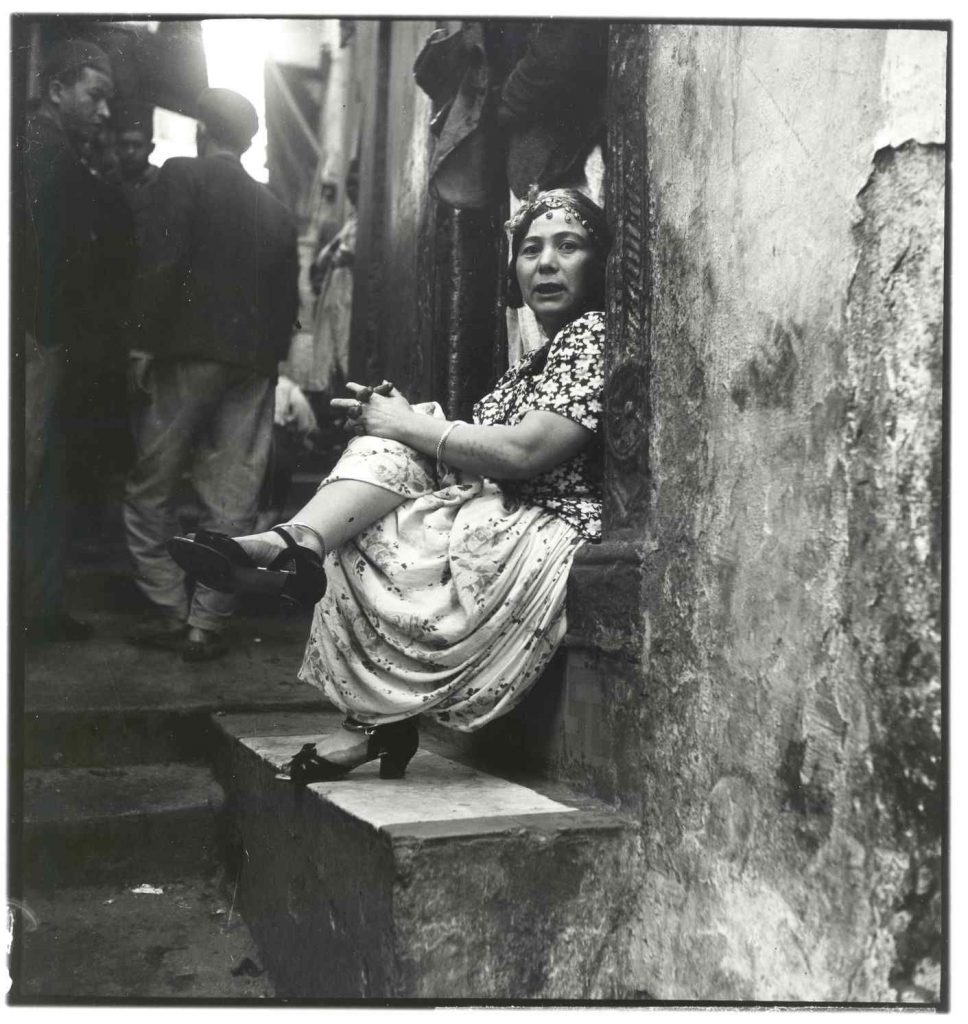
Prostitutes of Casablanca, photo via Emilie Benoist.
GEJ: Why was the regulatory system for prostitution in North Africa under French rule put in place, and what does this reveal about power relations between colonizers and the colonized?
CT: French colonists did not want to marry colonized women – notably because of scientific racism – but nonetheless ‘reserved’ some for sexual consumption. This required a system to allow the legal monopolization of these women. The French were the unquestionable victors, so they believed they had a ‘sexual right’ to the colonized. They knew they could not have access to all women, however, without exploding the foundations of colonial society. The male colonial elite negotiated which women would be ‘sacrificed’ to miscegenationand put coercive rules in place to control the process. That’s how the regulatory system for prostitution was born. Mixed sexual relations were channeled into a space that was not deemed problematic as it concerned women who had already been ‘degraded’ (former slaves, courtesans, prostitutes, etc.) by men from both societies. Many of these women were, however, involved in subversion and/or rebellion. These rebellions weren’t revolutions, but they were rebellions all the same.
The practice of prostitution and prostitutes themselves are often presented as marginal. That’s a mistake, because prostitution is at the heart of society. By studying prostitution, we can understand all power relations. When we take the time to listen to prostituted people, it stares us in the face: the centrality of commercialized sex allows us to see the violence of power relations between multiple and intersecting individuals. All of this is maximized in colonial prostitution, as prostitutes are subjected to extreme domination. We cannot pretend that it’s just about sex: it’s a matter of state. Algeria, for example, had almost always been occupied since the Phoenicians. From 1830, however, the main feature of colonization was the massive, unprecedented monopolization of women. This is all the more important given the centrality of a powerfully patriarchal society where male honour is measured by the control of women. Women were used to settle scores between men on both sides.
GEJ: The book shows just how our contemporary societies, especially in the former European colonial powers, are heavily imbued with the legacy of colonization in representations of race and gender, be they of women or men. How did representations of masculinity evolve in this context?
CT: This period saw a clear redefinition of masculinity across Europe. Efforts to domesticate men and channel their aggression, including sexual aggression, which caused lots of public order problems (brawls, honour killings, harassment, rapes, etc), began in the 1860s. Political leaders at the end of the nineteenth century were men of order in the full sense of the term: they regulated, categorized, and controlled everything; they wanted an ordered, rational, Cartesian society. Men would, therefore, be ‘trained’ in a certain form of masculinity in homosocial institutions like school, sports organizations, the army, and so on. This process aimed to construct what I call a ‘masculine righteousness’, an acceptable average. In the same period, doctors, particularly sex therapists, started explaining what ‘good’ sexuality was: the frequency of sexual relations, the nature of ‘acceptable’ practices, and the categorization of ‘perversions’. ‘Good sexual relations’ were, clearly, first and foremost heterosexual; the woman always had to be in a position of submission to an essentially procreational aim. To ensure this, sex had to be quite – but not too– regular. All of these heteronormative prescriptions contributed towards the codification of the sphere of intimacy. This was absorbed by colonial society, where the masculinity of colonized people would be constructed in opposition to that shaped by the ‘civilizing of mores’ of Europe from which they were excluded. This exercise in delegitimization did enormous damage because it called into question the masculine identity of colonized men in highly patriarchal societies.GEJ: How did this process feed the narrative that colonized men were inferior?
CT: Colonized men were delegitimized through two stigmatizing categories: an excess (being ‘too much’) or a fundamental lack (‘too little’). The first was that of the sexual predator: the hypermasculine compulsive rapist. In France, this was embodied in the enduring form of the ‘Arab’ who not only had a knife between his teeth but ‘his penis constantly hanging out of his trousers’. From the nineteenth century, we find texts saying ‘Rape is the Arab’s everyday pleasure’. This representation was useful on several levels then as it is today. On the one hand, it allowed sexual violence to be blamed on ‘those men over there’. On the other, it allowed ‘their’ women to continue to be controlled. This categorization is recorded in the wild, obsessive ideas about genital organs. Pseudo-scientific literature quibbled over the apparently oversized penises primarily of black men, who were represented as ‘big children’, then Arabs, who were ‘vicious’ and ‘perverted’. The categories of perversion being theorized at the time in French, German, and British sexual therapy was applied to, for example, Algerian society; in the Belle Epoque period, Arabs were presented as zoophiles, paedophiles, necrophiliacs, and sodomites, etc.
The second category of delegitimized masculinity led them to always be considered as ‘sub-’ or ‘too little’, as feeble and effeminate; not necessarily homosexual, but never fitting the masculine ideal. These ideas can be used separately and at the same time: men are simultaneously condemned for being both hyperfeminine and hypermasculine. Either way, in the colonial context, they were perceived as being unlike European men; as dangerous and to be avoided. The goal was to prevent the women of the colonizers from having sex with them, while at the same time the colonizers did not deny themselves the use of colonized women. This proves that sex was central because, if it wasn’t, there wouldn’t have been these sexual boundaries so strongly associated with colour or race.
GEJ: How do you connect your work with feminism?
CT: I’ve always been militant, and most of my political engagement has been feminist. I studied history because I know the French national narrative is powerfully ideologized; it excludes certain facts and values, and fails to represent some groups and individuals. Colonialism has, meanwhile, done lasting damage to many people and their societies. We are collectively responsible for that today, and must strive to repair it as much as possible. This begins by accepting the fact that we have only been – individually and collectively – imperfectly decolonized: we think we live in a world where relations between people are nominally equal, but we experience structural, systematic inequality every day. This is not, of course, only linked to colonization, but it nonetheless bears a great deal of responsibility because it was – and continues to be – one of the great sources of discrimination.
Feminism can help because it is a comprehensive political theory dedicated not just to women’s rights. It’s a ‘repair tool’ founded on consciousness-raising and self-liberation. This asks that we never project ourselves onto people we encounter, whether dead or alive. Each must take their own path. This is very much an integral part of feminism. That’s why I categorically reject the notion of absolute and definitive victimhood.
GEJ: Returning to the controversy generated by the book, you say you are not lumping together questions of domination and questions of violence.
CT: It is problematic to start from the principle that an image – which is necessarily a construction – is ‘reality’. Similarly, believing that what we see (and we always see what we want) is real can lead to the falsification of an image’s content through anachronism or dogmatism. Of course, I’m not saying that there arent victims or systems of domination – I’m saying quite the opposite – but that doesn’t change how individuals also have strategies for accommodation so they can live in societies as they are, including when they are terribly coercive. These strategies are also important for understanding their personal choices and individuality; there can, for example, be acts of resistance in the face of intersecting forms of patriarchal and/or colonial domination.
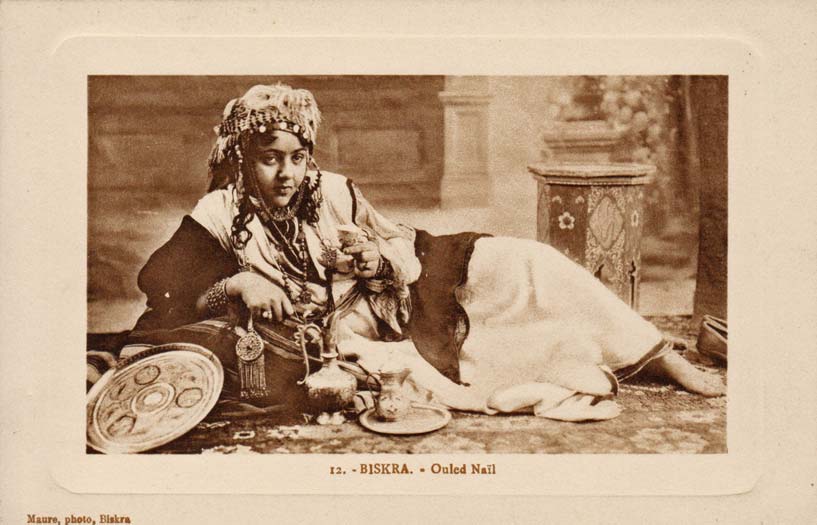
A bejeweled Ouled Naïl stretched out on a carpet in her traditional outfit glances up at the camera. In her hand is a cup of coffee, as much a mainstay in orientalist portrayals as the hookah in connoting sensual ambiance. Courtesy of Alan Petrulis via metropostcard.com
GEJ: Before the publication of Sexe, race et colonies, a major newspaper published some fairly hardcore images featured in the book, which provoked outrage in some militant decolonial and Afrofeminist circles. What did you think about this controversy?
CT: I can understand ‘Our Bodies’, the opinion piece by Cases Rebelles, but I think there’s been a misunderstanding, because these aren’t ‘our’ or ‘their’ bodies. These women are not bodies at all and belong to nobody but themselves. To understand them, we have to search for them, emphasizing their paradoxical, ambivalent, and contradictory, stories. This is often difficult because the archives are mostly silent. We must not start from the principle that ‘we are them’ and ‘they are us’. Resituating them in a complex human context is not to deny the violence of domination but, rather, to give ourselves the chance to eradicate domination altogether. In the 2000 national survey on violence against women in France, Maryse Jaspard quite rightly reminded us that racialized women suffer more sexual violence than other women, in both French overseas territories and continental France. This is precisely because everything the book talks about is still there: this violence is alive, persistent – it’s not a relic.
I don’t believe that I hold the truth. My role is to train critical minds, starting with my own: stepping back from one’s own prejudices, working from one’s ambivalences. But I’m fully engaged in this approach because I am convinced that there are important things at stake in France and European and global society more broadly. This book, though not perfect, can be very useful because first and foremost it’s a weapon of war.
Published 4 December 2019
Original in French
First published by Green European Journal
Contributed by Green European Journal / Eurozine © Green European Journal / Christelle Taraud / Eurozine
PDF/PRINTIn collaboration with
Newsletter
Subscribe to know what’s worth thinking about.
Related Articles
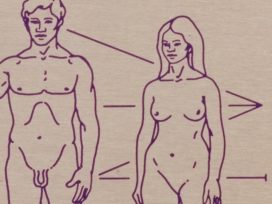
Why was the distinguishing mark of female genitalia erased from NASA’s 1970s image travelling outer space? And will compromised depictions of life on Earth avoid sexist, racist and anthropocentric simplifications by 2036?

While book publishing is an ailing industry, children’s books are booming. But political attacks and censorship are also threatening this thriving sector.
